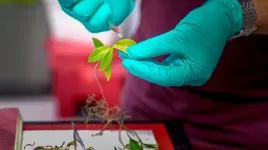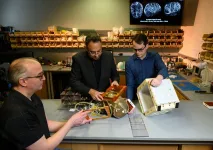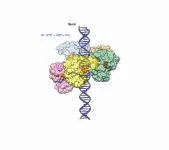(Press-News.org) Philadelphia, June 3, 2021 - Researchers at Children's Hospital of Philadelphia (CHOP) have demonstrated how to use standardized reporting of clinical data for seizures caused by a variety of neurological disorders, providing fundamental baseline information that can determine what methods work best for keeping seizures under control. The findings were published today in the journal Epilepsia.
In order to make improvements in epilepsy care, clinicians need a reliable and efficient method to measure outcomes. While Electronic Medical Records (EMR) are being used more frequently for research and quality improvement, important epilepsy outcome measures such as seizure frequency or quality of life are not documented in a standardized way that enables researchers to process large-scale data on the subject.
To help standardize how clinical data is recorded for epilepsy visits, the team at CHOP began using common data elements (CDEs) to ensure that relevant data is captured in a comparable way across studies and clinical visits. In this study, the researchers assessed the results from using CDEs in routine care for pediatric epilepsy over a 12-month period.
"For those of us who treat pediatric epilepsy patients, we are constantly trying to assess how we're doing and how we can improve outcomes for our patients," said Mark P. Fitzgerald, MD, PhD, a pediatric neurologist in the Division of Neurology at CHOP and first author of the study. "This study provides us with fundamental data that will serve as the foundation for how we treat our patients and inform how we achieve the best patient-centered outcomes possible."
The researchers looked at almost 1,700 visits by more than 1,000 individual patients with childhood epilepsies. The study covered a period of approximately one year, with visits conducted by 32 different providers across the CHOP Network. Overall, 43% of patients had at least one seizure a month, 17% had at least one seizure each day, and 18% of patients were free of seizures for at least one year. The most common epilepsy syndromes were Childhood Absence Epilepsy, Lennox-Gastaut Syndrome, and Dravet Syndrome. The researchers were able to quantify the absolute seizure burden as well as changes in seizure burden over time and the differences between syndromes.
Additionally, because this study was conducted as the COVID-19 pandemic began, the researchers assessed the use of telemedicine to record this information. They found that patients had comparable seizure frequencies whether assessed in-person or via telemedicine. The study also found that patients identifying as Hispanic or Latino, particular from areas with lower median household incomes, were more likely to have ongoing seizures that worsened over time.
"Currently, CHOP is the only neurology program that generates this level of patient information from ongoing care rather than research studies only," said senior author Ingo Helbig, MD, attending physician and director of the genomic and data science core of Epilepsy Neurogenetics Initiative (ENGIN) at CHOP. "This study represents a major paradigm shift in how we assess and deliver care to our pediatric neurology patients."
INFORMATION:
This study was supported by The Hartwell Foundation through an Individual Biomedical Research Award, the National Institute for Neurological Disorders and Stroke (K02 NS112600), including support through the Center Without Walls on ion channel function in epilepsy ("Channelopathy-associated Research Center", U54 NS108874), the Eunice Kennedy Shriver National Institute of Child Health and Human Development through the Intellectual and Developmental Disabilities Research Center (IDDRC) at CHOP and the University of Pennsylvania (U54 HD086984), and by intramural funds of the Children's Hospital of Philadelphia through the Epilepsy NeuroGenetics Initiative. This study was also supported by the National Center for Advancing Translational Sciences of the National Institutes of Health under Award Number UL1TR001878, the German Research Foundation (DFG; HE5415/3-1, HE5415/5- 1, and HE5415/6-1) and the DFG/FNR INTER Research Unit FOR2715 (He5415/7-1). This project was further supported in part by the Institute for Translational Medicine and Therapeutics' (ITMAT) Transdisciplinary Program in Translational Medicine and Therapeutics at the Perelman School of Medicine of the University of Pennsylvania, and the International League Against Epilepsy (ILAE).
Fitzgerald et al, "Assessing seizure burden in pediatric epilepsy using an electronic medical record-based tool through a common data element approach." Epilepsia, online June 2, 2021. DOI: 10.1111/epi.16934.
About Children's Hospital of Philadelphia: Children's Hospital of Philadelphia was founded in 1855 as the nation's first pediatric hospital. Through its long-standing commitment to providing exceptional patient care, training new generations of pediatric healthcare professionals, and pioneering major research initiatives, Children's Hospital has fostered many discoveries that have benefited children worldwide. Its pediatric research program is among the largest in the country. In addition, its unique family-centered care and public service programs have brought the 595-bed hospital recognition as a leading advocate for children and adolescents. For more information, visit http://www.chop.edu.
MUSC Hollings Cancer Center researchers are finding solutions to the aging-related changes that reduce anti-cancer immunity. Besim Ogretmen, Ph.D., and colleagues found a novel link between aging, metabolism and anti-cancer T-cell function. Their work, published in Cell Reports, sheds light on an important pathway that cannot be ignored during cancer treatment.
Two broad questions in cancer research are: How can cancer treatments be improved, and what is the link between cancer and aging?
"We know that the protective T-cell response deteriorates with age. Mitochondrial function is now thought to be one of the central regulators of the aging process. Our experiments connected the dots with what was previously shown and highlighted some ...
Thursday, June 3, 2021, CLEVELAND: A Cleveland Clinic study shows that survivors of COVID-19 who have moderate or severe obesity may have a greater risk of experiencing long-term consequences of the disease, compared with patients who do not have obesity. The study was recently published online in the journal of Diabetes, Obesity and Metabolism.
Multiple studies have identified obesity as a risk factor for developing a severe form of COVID-19 that may require hospital admission, intensive care, and ventilator support in the early phase of the disease. Obesity, which is a complex disease caused by multiple factors, is associated with an increased risk for cardiovascular ...
DURHAM, N.H.-- Bears are known for being devoted and protective of their baby cubs, but research from the University of New Hampshire shows that they may also play a significant role in shielding gray fox from predators like coyotes, who compete with the fox for food and space. The research is one of the first studies to show how black bears provide a buffer to allow other, smaller carnivores to safely co-exist.
"Even though black bears and coyotes are the two most common carnivores in North America, we're still learning how they affect the ecosystems around them," said Rem Moll, assistant professor of wildlife ecology and lead author ...
The fabrication device for the battery revolution looks quite unconspicuous: It is a modified, commercially available 3D printer, located in a room in the Empa laboratory building. But the real innovation lies within the recipe for the gelatinous inks this printer can dispense onto a surface. The mixture in question consists of cellulose nanofibers and cellulose nanocrystallites, plus carbon in the form of carbon black, graphite and activated carbon. To liquefy all this, the researchers use glycerin, water and two different types of alcohol. Plus a pinch of table salt for ionic conductivity.
A sandwich of four layers
To build a functioning supercapacitor from these ingredients, four layers are needed, all flowing out of the 3D printer one after the ...
Left- or right-handedness is a symmetry property that many macroscopic objects also exhibit and which is of immense importance, particularly for the bioactivity of organic molecules. Chirality is also relevant for physical or chemical properties such as optical activity or enantioselectivity of crystalline solids or their surfaces. In the case of chiral metallic phases, unconventional superconductivity and unusual magnetic ordered states are linked to the chirality of the underly-ing crystal structure. Despite this connection between chirality and the properties of a material, detection is often difficult because left-handed and righthanded ...
The expansion of wind energy in the German Bight and the Baltic Sea has accelerated enormously in recent years. The first systems went into operation in 2008. Today, wind turbines with an output of around 8,000 megawatts rotate in German waters, which corresponds to around eight nuclear power plants. But space is limited. For this reason, wind farms are sometimes built very close to one another. A team led by Dr. Naveed Akhtar from Helmholtz Zentrum Hereon has found that wind speeds at the downstream windfarm are significantly slowed down. As the researchers now write in the journal Nature Scientific Reports, this braking effect results in astonishingly large-scale low wind pattern noticeable in mean ...
Neurodegenerative disorders that cause dementia increase the risk of contracting severe COVID-19 and dying from the disease. For people with Alzheimer's the risk is three times greater. It can be six times greater if they are over 80, according to a study conducted in Brazil by researchers at the University of São Paulo (USP) and Butantan Institute in partnership with colleagues at the Federal University of Rio de Janeiro (UFRJ).
An article on the study, which was supported by FAPESP, is published in Alzheimer's & Dementia: The Journal of the Alzheimer's Association.
"We found that all causes of dementia are risk factors for severity and death in COVID-19 and that these ...
ITHACA, N.Y. - Water regulation in leaves is vital to a plant's health, affecting its growth and yield, disease susceptibility and drought resistance.
A breakthrough technology developed by Cornell University researchers uses nanoscale sensors and fiber optics to measure water status just inside a leaf's surface, where water in plants is most actively managed.
The engineering feat provides a minimally invasive research tool that will greatly advance the understanding of basic plant biology, and opens the door for breeding more drought-resistant crops. The technology could eventually be adapted for use as an agronomic tool for measuring water status in crops in real time.
The study in maize plants, "A Minimally Disruptive Method for Measuring Water Potential In-Planta ...
Sickle Cell Disease (SCD) is a genetically inherited group of red blood cell disorders. END ...
DURHAM, N.C. - A group of researchers have discovered the detailed inner workings of the molecular motor that packages genetic material into double-stranded DNA viruses. The advance provides insight into a critical step in the reproduction cycle of viruses such as pox- herpes- and adeno-viruses. It could also give inspiration to researchers creating microscopic machines based on naturally occurring biomotors.
The research was conducted by scientists from Duke University, the University of Minnesota, the University of Massachusetts and the University of Texas Medical Branch (UTMB). The results appear online in a trilogy of papers published in Science Advances, ...






